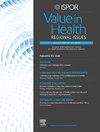评价莫桑比克城市卫生相关生活质量指数:离散选择实验
IF 1.4
Q3 HEALTH CARE SCIENCES & SERVICES
引用次数: 0
摘要
目的全球共有15亿人缺乏基本卫生设施。卫生相关生活质量的五属性指数(SanQoL-5)已在9个国家应用。SanQoL-5属性及其级别需要加权(估值),得到的指数范围从0到1。迄今为止,SanQoL-5估值应用了简单的方法,如秩和,而不是稳健的方法,如离散选择实验(DCE)。我们的目标是在莫桑比克城市使用DCE评估SanQoL-5。方法我们在马普托和东多市招募了601名成年人,男女抽样相同。DCE任务是在SanQoL-5属性级别的2种组合中选择哪一种“更好”(总是,有时,从不)。每个被调查者完成了10个任务和一个支配性测试。在拟合混合logit模型后,我们重新缩放系数来推导指数。结果厌恶(“上厕所时从不感到恶心”)属性值最高,为0.25。其他属性具有相似的值(范围为0.18-0.19)。人们对“有时”级别的重视程度大约是“从不”级别的60%。因此,从中间水平到最差水平的减量要比从最好水平到中间水平的减量大。厕所类型的平均SanQoL-5遵循可持续发展目标6类别的梯度:“露天排便”0.30,“未改善”0.45,“有限”0.60和“至少基本”0.70。据我们所知,这是第一次基于dce对卫生相关生活质量指标进行评估,使SanQoL-5能够用于经济评估。确定与最大程度提高生活质量相关的卫生服务转型,可为更有效地分配资源提供信息。本文章由计算机程序翻译,如有差异,请以英文原文为准。
Valuing an Index of Sanitation-Related Quality of Life in Urban Mozambique: A Discrete Choice Experiment
Objectives
A total of 1.5 billion people live without basic sanitation. A 5-attribute index of sanitation-related quality of life (SanQoL-5) has been applied in 9 countries. SanQoL-5 attributes and their levels require weighting (valuation), with the resulting index ranging from 0 to 1. To date, SanQoL-5 valuation applied simple methods such as rank sum, not robust methods such as discrete choice experiment (DCE). We aimed to value SanQoL-5 using a DCE in urban Mozambique.
Methods
We enrolled 601 adults in the cities of Maputo and Dondo, sampling women and men equally. The DCE task was a choice of which was “better” among 2 combinations of SanQoL-5 attribute levels (always, sometimes, never). Each respondent completed 10 tasks and a dominance test. After fitting a mixed logit model, we rescaled coefficients to derive the index.
Results
The highest-valued attribute was disgust (“never feel disgusted while using the toilet”) at 0.25. The other attributes had similar values (ranging 0.18-0.19). People valued “sometimes” levels at approximately 60% of “never” levels. Therefore, moving from the middle level to the worst involves a larger decrement than moving from the best to the middle. Mean SanQoL-5 by toilet type followed a gradient with Sustainable Development Goal 6 categories: “open defecation” 0.30, “unimproved” 0.45, “limited” 0.60, and “at least basic” 0.70.
Conclusions
To our knowledge, this is the first DCE-based valuation of any index of sanitation-related quality of life, enabling SanQoL-5 to be used in economic evaluation. Identifying sanitation service transitions associated with the greatest quality of life gains could inform more efficient resource allocation.
求助全文
通过发布文献求助,成功后即可免费获取论文全文。
去求助
来源期刊

Value in health regional issues
Pharmacology, Toxicology and Pharmaceutics-Pharmacology, Toxicology and Pharmaceutics (miscellaneous)
CiteScore
2.60
自引率
5.00%
发文量
127
 求助内容:
求助内容: 应助结果提醒方式:
应助结果提醒方式:


